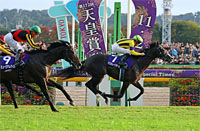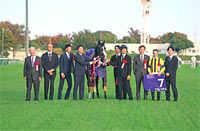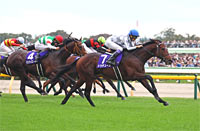2023 News
Equinox Validates Status as World’s Best with Record Win in Tenno Sho (Autumn)Attended by both the Emperor Naruhito and Empress Masako, heavy favorite Equinox set a new track record that shortened the previous time by 0.9 seconds to a staggering 1:55.2 over the 2,000-meter trip, and became the third horse after Symboli Kris S (2002-2003) and Almond Eye (2019-2020) to successfully defend his title in this year’s Tenno Sho (Autumn). The victory extended his winning streak, all at G1 status, to five since his last victory in the same race last year followed by the Arima Kiken (2,500m), the 2023 Dubai Sheema Classic (2,410m) and the Takarazuka Kinen (2,200m) this spring. Trainer Tetsuya Kimura claimed his sixth JRA-G1 title, the latest being the Takarazuka Kinen with this colt, while jockey Christophe Lemaire had just won the Kikuka Sho (Japanese St. Leger) with Durezza last week and registered his 47th JRA-G1 title with his fifth Tenno Sho (Autumn) victory after with Rey de Oro in 2018, Almond Eye in 2019 and 2020 and this colt in last year. With all eleven starters breaking smoothly, Equinox followed Jack d’Or, who rushed out for the lead and set the pace, into a nice forward position, just off the rails, in third position. Maintaining a nice rhythm a few lengths behind the leader who set a rapid pace that timed 57.7 seconds in the first half (1,000 meters), Equinox was already within a length distance from Gaia Force who inherited the lead at the 400-meter pole and as soon as overtaking that foe with 300 meters to go, the Kitasan Black colt pulled away easily and uncontested for a 2-1/2-lengths victory. “First of all, I am relieved to have been able to show the world, which I know was watching how the race favorite would run, that he is indeed a deserving colt to be named the highest rated colt. He’s not exactly what you call a horse with incredible speed but he was able to keep up with today’s rapid pace and get into another gear at the end—but I was actually surprised when I realized that we had won in a record. He is a versatile horse that can run from any position, stay calm during the race and make use of his speed at the finish. He can also run at longer distances such as when he won the Arima Kinen, so although there was much pressure coming into such a prestigious race as race favorite, I was confident knowing what he is capable of,” commented Christophe Lemaire after the race. Sixth pick Justin Palace was unhurried after a smooth break, sitting well off the pace and more than 10 lengths from the leader along the backstretch. Last to enter the stretch as the field closed in rounding the final corner, the Deep Impact colt followed Prognosis and shifted further out for a clear path where he exerted a fine turn of speed that timed the fastest over the last three furlongs to secure the runner-up spot while unable to cause any threat to the winner. Third favorite Prognosis traveled in the far rear through the first half and joined the rest of the field rounding the final turn while still positioned near the rear. Shifting out for a clear stretch run, the five-year-old son of Deep Impact responded well to reach contention 200 meters out in a rally for second and while beaten by Justin Palace at the 100-meter marker, managed to out-finish Danon Beluga by a head for third. Other Horses: 
THE 168TH TENNO SHO (AUTUMN) (G1)
*Rider replaced from Yutaka Take (injured from being kicked after race 5) FP: Final Position / BK: Bracket Number / PP: Post Position / S&A: Sex & Age / Wgt: Weight (kg) / DH: Dead Heat / L3F: Time of Last 3 Furlongs (600m)
Color: b.=bay / bl.=black / br.=brown / ch.=chestnut / d.b.=dark bay / d.ch.=dark chestnut / g.=gray / w.=white
Turnover for the Race alone: ¥ 23,445,782,800 Turnover for the Day: ¥ 33,674,161,000 Attendance: 77,870 PAY-OFF (for ¥100)
Winner= 9 starts: 7 wins & 2 seconds / Added & stakes money: ¥ 222,394,000 / Career earnings: ¥ 1,711,582,100
* Tenno Sho (Autumn) (G1) “The Emperor’s Cup” was first held in 1905 to encourage the horse racing sport through annual events that gave the winner the highest honor of being awarded the Imperial prize. Then the Tenno Sho (Autumn) was established in 1937 together with its counterpart, Tenno Sho (Spring), under the name “Teishitsu Goshoten Kyoso” and held biannually in both the Eastern and Western part of Japan. The race was officially renamed the “Tenno Sho” in 1947. Both the spring and autumn races, which secured its status as the most prestigious events for older horses, were run over 3,200 meters in the early years. Later, the autumn version was shortened to 2,000 meters in 1984 so that the spring version could determine the best stayer, while the Tenno Sho (Autumn) would be the main target for middle-distance champions. This also gives the three-year-olds, who find the third leg of the Triple Crown, the Kikuka Sho (Japanese St. Leger, G1, 3,000m), to be beyond their suitability, an alternative G1 as the ultimate goal for their autumn campaign. The Tenno Sho (Autumn) entered a new chapter in its long history when opening its doors to foreign contenders as an international race in 2005. |
|




















